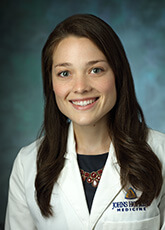Takeaway
The clinically excellent practice is centered on core humanistic values rather than on efficiency or productivity.

Connecting with Patients | January 14, 2020 | 3 min read
By Madeline Rodriguez, MD, Johns Hopkins University School of Medicine
Winter is traditionally a difficult time for trainees. It’s cold, the early darkness gives you the sense of perpetual night, and fatigue often blurs the vision of the doctor you hoped to be. The winter of my intern year was no exception, and I found myself reflecting on that vision: a doctor who spent real time with her patients, created meaningful relationships with them, and preserved their dignity. At the beginning of a particularly difficult wards block, Mrs. C gave me the opportunity to practice my intentions.
Mrs. C was a 62-year-old wife and yoga instructor with metastatic lung cancer, a direct admission for adverse effects of chemotherapy. Her last treatment left her unable to tolerate anything by mouth. She was nauseated and in pain, but unapologetically herself in our first encounter—vibrant, sarcastic, and full of gallows humor. Her mother had died of cancer at 67, and she was not ready to give up. Though I had heard this battle cry before, I knew the person declaring it was different.
I spent the last half hour of each day asking how she was feeling, and then how she was feeling. Together, we wondered about her future and talked about how I should really start doing yoga. She missed her anniversary, but shared her entire wedding album with me. It was their second marriage, so they decided to get married on a cruise— they loved cruises—and her crazy aunts came from Italy to be there. I missed my birthday, but shared one of my own wedding pictures with her; “young pups,” she said, as she encouraged me to go home and spend time with my husband. We lived in the same part of town.
10 days later, she was ready to go home and I made sure to be there when she was leaving.
“Can I give you a hug?” asked her husband.
“Of course!” I replied, and we held each other.
I turned to Mrs. C and asked, “Do you hug?”
“Yes,” she said smiling, and we embraced knowing we were unlikely to meet again.
I checked her chart every few weeks to see how she was doing, and, if I’m being completely honest, to see if she had passed. In the winter of my second year, I received an email from my neighborhood group, the subject line: funeral arrangements. My heart sank as I had the experience I’ve had a million times before: despite knowing the ultimate outcome of a disease—rationally and medically—I sat in utter disbelief of its actualization.
I hope I gave you all I could, and you know how much you changed me. I hope your husband is doing ok, the gentle soul he is. I hope you know I think of you often, especially when I feel too tired to be the type of doctor I think I should. Rest in joy.
Lessons learned in shared humanity
Mrs. C taught me many things, but perhaps the most important was to center my clinical practice on my core values—empathy, compassion, and humanism. Trainees are often taught to adopt a new set of values—efficiency, objectivity, and clinical mastery—that are necessary to survive, and even thrive, in training and the “real world” beyond it. Acting alone, however, those values may facilitate treating diseases rather than the individuals who suffer from them. In our current era of burnout and wellness—often conflating one for the absence of the other—it’s important to return to the bedside as much to evaluate our patients as to share our vulnerability. Mrs. C taught me the beauty of that vulnerable exchange, which I think is best embodied by one of my favorite quotations from Pema Chödrön:
“Compassion is not a relationship between the healer and the wounded. It’s a relationship between equals. Only when we know our own darkness well can we be present with the darkness of others. Compassion becomes real when we recognize our shared humanity.”
Thank you, Mrs. C, for reminding me to see my patients always as equals. It was a privilege to walk alongside you.
This piece grew out of a writing workshop with author Suzanne Koven, MD, MFA, who shares her joy of storytelling in medicine with lifelong learners around the world.

